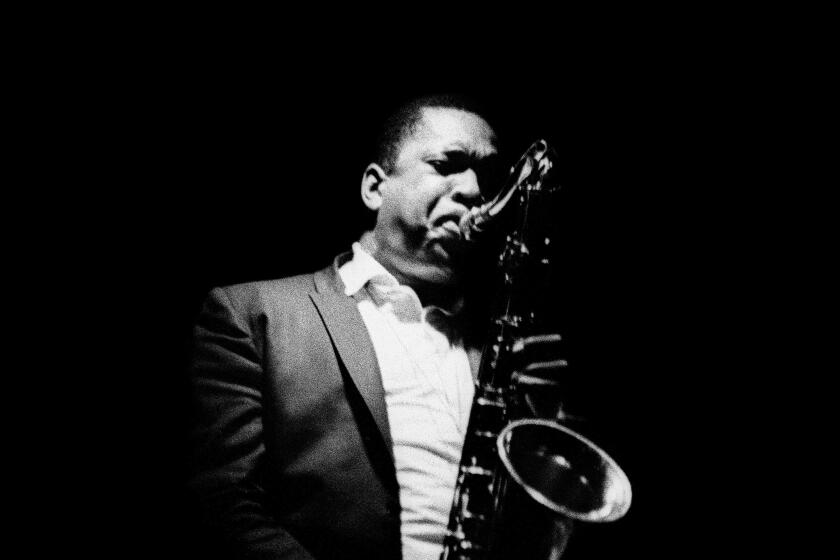Column: Finding salvation from dark places through Ledisi and Nina Simone

Back in July, while performing at the Hollywood Bowl, the Grammy-winning artist Ledisi shared a story about the day in 2003 when Nina Simone saved her life.
Ledisi was in her late 20s, depressed, newly divorced and struggling with money problems. One day, while sitting in a rocking chair on the porch of her Oakland home listening to the radio, she started “thinking how to leave the Earth.”
“That’s how dark it was,” Ledisi told the crowd, and their laughter in response to a joke she had made seconds earlier was replaced by an uneasy stillness.
Talk of suicide tends to do that to people. Watching a video from that night, I paused the clip to digest Ledisi’s words. I thought about my own struggles with suicidal thoughts as a teen. I thought about Kurt Cobain, who took his own life in 1994, and the heart-wrenching note he left that referenced Neil Young: “It’s better to burn out than to fade away.” I thought about Phyllis Hyman, who took her life in 1995, and the chorus of one of her biggest hits: “I can’t stand this living all alone.” One of Linkin Park’s last singles before lead singer Chester Bennington’s death by suicide repeatedly asked, “Why is everything so heavy?”
Opinion Columnist
LZ Granderson
LZ Granderson writes about culture, politics, sports and navigating life in America.
What would people have remembered about Ledisi had she followed those dark thoughts? What would we have lost had Nina Simone’s powerful voice not touched her? Reached her?
“I said who the hell is that?” Ledisi told the Bowl crowd. “I start listening and getting up close to the radio.… She said, ‘Trouble in mind, I’m blue, but I won’t be blue always.’”
It’s a beautiful moment, full of vulnerability, storytelling, humor. And while Ledisi has paid homage to Nina Simone many times over since that day in Oakland, it’s hard to imagine a more perfect tribute to the “High Priestess of Soul” than her album earlier this year, “Ledisi Sings Nina.”
I’m not one who likes to rank art at the end of the year, but whenever an artist of Ledisi’s caliber sings songs of their salvation, listening becomes more than an auditory experience. It’s a deeply spiritual one. And no matter how down I’ve found myself this year — covering politics, trials with racial overtones, COVID — “Ledisi Sings Nina” never failed to lift me up.
For seven tracks, beginning with the ubiquitous classic “Feeling Good,” the classically trained singer explores, but never wanders too far away from, Simone’s original intent or temperament. The liberties both she and Metropole Orkest — the famed orchestra that accompanied her on the album and at the Bowl — take with the arrangements showcase the remarkable range of Ledisi’s voice. Other Simone covers I’ve heard can feel more like attempts to hide a vocalist’s shortcomings. That’s not meant to be shade. That’s recognizing there’s more to singing Nina Simone than simply hitting the right notes at the right time.
In fact, Ledisi’s four-octave voice is very different from Simone’s alto, but there is kinship there. Sisterhood. Ledisi and Simone do not sound the same when they belt, “My name is Peaches” — the last line from “Four Women” — but it feels the same. It does because of a mutual understanding of what it means to narrate Peaches’ life — in 1966, when Simone released the original, as well as in 2021. Anyone can hit the right notes, but you can’t fake the intent behind them. And in a world saturated with auto-tuned hits, “not faking it” is a precious commodity.
I’ve probably listened to John Coltrane’s “A Love Supreme” 50 times during the pandemic, because it does what only great art can do — it holds me up.
After learning that this incredibly gifted and beautiful soul was once “thinking how to leave the earth,” I started listening to “Ledisi Sings Nina” with different ears. She doesn’t just sing the material; she has an intimate relationship with it. When Ledisi sings, “It’s a new dawn, it’s a new day, it’s a new life for me,” there is a truth there that rises above the lush arrangement, without the two ever being in conflict.
Each time I listen to Ledisi’s version of “Ne Me Quitte Pas (Don’t Leave Me),” I wonder what — or who — was on Ledisi’s mind as she was recording it. And each time I draw a different conclusion — likely a reflection of how I’m processing these uncertain times more than anything else.
That’s the true beauty of “Ledisi Sings Nina” — although some of the lyrics were penned more than half a century ago, Ledisi molds them with contemporary hands, creating a stunning piece of art. It is a thank-you to the voice that led to her salvation. It is a note of encouragement for those who may find themselves in a dark space. It is a prayer for fewer dark spaces for us all.
More to Read
A cure for the common opinion
Get thought-provoking perspectives with our weekly newsletter.
You may occasionally receive promotional content from the Los Angeles Times.













